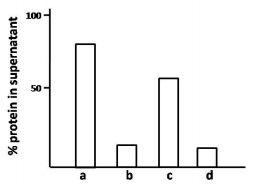 Multiple Choice Questions
Multiple Choice QuestionsWhich genes have been introduced in Bollgard II cotton to get resistance against cotton bollworm, tobacco budworm, and pink bollworm?
cry1Ab + cry1Ac
cryAc + cry2Ab
cry1Ab + cry2Ab
cry9C + cry2Ab
The presence and distribution of specific mRNAs within a cell can be detected by
Northern blot analysis
RNase protection assay
in situ hybridization
real-time PCR
The tetanus vaccine given to humans in the case of a deep cut is a
DNA vaccine
recombinant vector vaccine
subunit vaccine
toxoid vaccine
The electrospray ionization spectrum of a mixture of two peptides show peaks with m/z values 301, 401, 501, and 601. The molecular weights of the peptides are
1200 and 1250
1200 and 1500
1350 and 1500
1250 and 1350
From the following statements,
A. Hydrogen, Deuterium, and Tritium differ in the number of protons.
B. Hydrogen, Deuterium, and Tritium differ in the number of neutrons.
C. Both Deuterium and Tritium are radioactive and decay to hydrogen and deuterium, respectively.
D. Tritium is radioactive and decays to Helium.
E. Carbon-14 decays to Nitrogen-14.
F. Carbon-14 decays to Carbon-13.
Pick the combination with ALL correct statements.
A, B, and F
B, D, and E
A, C, and D
C, E, and F
A researcher investigated a set of conditions for a protein with an isoelectric point of 6.5 and also binds to calcium. This protein was subjected to four independent treatments:(i) pH 6.4; (ii) 10% glycerol; (iii) 10mM CaCl2; (iv) 40% ammonium sulphate. This was followed by centrifugation and estimation of the protein in the supernatant. The results are depicted in the graph below:

Which of the following treatments best represents the results shown in the graph?
a = ammonium sulphate; b = glycerol; c = pH 6.4; d = CaCl2
a = CaCl2; b = glycerol; c = ammonium sulphate; d = pH 6.4
a = pH 6.4; b = CaCl2; c = ammonium sulphate; d = glycerol
a = CaCl2; b = pH 6.4; c = glycerol; d = ammonium sulphate
In an experiment, red blood cells were subjected to lysis and any unbroken cells were removed by centrifugation at 600 g. The supernatant was taken and certified at 100,000 g. The pellet was extracted with 5M NaCl and again centrifuged at 100,000g. Which of the following proteins would be present in the supernatant?
band 3
Glycophorin
G protein-coupled receptor
Spectrin
D.
Spectrin
Spectrin would be present in the supernatant.
Fluorescently tagged protein was used to study protein secretion in yeast. Fluorescence was observed in:
(a) the Golgi
(b) the secretory vesicles
(c) the rough ER
Which of the following describes best the sequence in which these events occur?
(a) → (b) → (c)
(b) → (c) → (a)
(c) → (a) → (b)
(c) → (b) → (a)
Three met E. coli mutant strains were isolated. To study the nature of mutation these mutant strains were treated with mutagens EMS or proflavins and scored for revertants. The results obtained are summarized below:
| Mutant strain | Mutagen treatment - EMS | Mutage treatment - Proflavin |
| A | - | + |
| B | + | - |
| C | - | - |
(+ stands for revertants of the original mutants and - stands for no revertats obtained)
Based on the above and the typical mutagenic effects of EMS and proflavin, what was the nature of the original mutation in each strain?
A - Transversion; B - Insertion or deletion of a single base; C - Deletion of multiple bases
A - Transition;B - Transversion; C - Insertion or deletion of a single base
A - Insertion or deletion of a single base; B - Transition; C - Deletion of multiple bases
A - Transition; B - Insertion or deletion of multiple bases; C -Transversion
Agrobacterium Ti plasmid vectors are used to generate transgenic plants. The following are examples of vir gene-encoded proteins that are important for the transfer of T-DNA into plants:
A. Vir E, a single-stranded DNA binding protein.
B. Vir D2 that generates T-strands.
C. Vir A that senses phenolic compounds.
D. Vir F which directs T-complex proteins for destruction in proteasomes.
Which one of the following combinations of proteins functions inside the plant cells?
Only A and C
A, B, and C
Only B and C
A, B, and D
